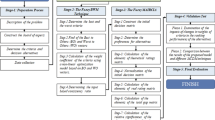Abstract
Multi-objective optimization of urban bus network can help improve operation efficiency of the transit system and develop strategies for reducing urban traffic congestion in China. The work used cumulative prospect theory, currently the most influential model for decision under uncertainty, to optimize urban bus network. To achieve the research objective, the work developed the theoretical framework of urban bus network optimization, including optimization principle, optimization objectives and constraints. Furthermore, optimization objectives could comprehensively reflect expectations of passengers and bus companies from the dimension of time, space and value. It is more scientific and reasonable compared with only one stakeholder or dimension alone in the previous studies. In addition, the technique for order preference by similarity to ideal solution (TOPSIS) was used to determine the positive and negative ideal alternative. The correlations between the optimization alternatives and the ideal alternatives were estimated by grey relational analysis simultaneously. The cumulative prospect theory (CPT) was used to determine the best alternative by comparing comprehensive prospect value of every alternative, accurately describing decision-making behavior compared with expected utility theory in actual life. Finally, Case of Xi’an showed that the method can better adjust the bus network, and the optimization solution is more reasonable to meet the actual needs.
Similar content being viewed by others
References
Liu H D, Design theory on public transport network and implement method, Doctoral Dissertation, Tongji University, Shanghai, 2008.
Wang J L and Liu D, Study on urban public transportation project evaluation, Journal of Transportation Systems Engineering and Information Technology, 2002, 2(1): 70–73.
Magnanti T L and Wong R T, Network design and transportation planning: Models and algorithms, Transportation Science, 1984, 18(1): 1–55.
Lin Z P, A discussion on the mechanism and optimization decision models of sustainable development of metropolitan transportation, Human Geography, 2001, 16(3): 37–40.
Liu W H, Yan Q P, and Long X Q, Analysis of evaluation indexes quantum used in the yard layout of highway hub, China Journal of Highway and Transport, 2003, 16(2): 86–89.
Jovic J, Modern tools in transportation planning: Transport model of Belgrade, European Transport, 2003, 24: 31–38.
Bazaras J, Jablonskytė J, and Jotautienė E, Interdependence of noise and traffic flow, Transport, 2008, 23(1): 67–72.
Daunoras J, Bagdonas V, and Gargasas V, City transport monitoring and routes optimal management system, Transport, 2008, 23(2): 144–149.
Matis P, Finding a solution for a complex street routing problem using the mixed transportation mode, Transport, 2010, 25(1): 29–35.
Matis P, Decision support system for solving the street routing problem, Transport, 2008, 23(3): 230–235.
Saunders M J, Kuhnimhof T, Chlond B, and Rodrigues da Silva A N, Incorporating transport energy into urban planning, Transportation Research Part A: Policy and Practice, 2008, 42(6): 874–882.
Filipović S, Tica S, Živanović P, and Milovanović B, Comparative analysis of the basic features of the expected and perceived quality of mass passenger public transport service in Belgrade, Transport, 2009, 24(4): 265–273.
Junevičius R and Bogdevičius M, Mathematical modeling of network traffic flow, Transport, 2009, 24(4): 333–338.
Mesarec B and Lep M, Combining the grid-based spatial planning and network-based transport planning, Technological and Economic Development of Economy, 2009, 15(1): 60–77.
Paslawski J, Flexibility in highway noise management, Transport, 2009, 24(1): 66–75.
Griškevičiūtė-Gečienė A, The evaluation of investment projects within the territory of development, Transport, 2010, 25(2): 203–214.
Jakimavičius M and Burinskienė M, Route planning methodology of an advanced traveler information system in Vilnius city, Transport, 2010, 25(2): 171–177.
Jović J and Dorić V, Traffic and environmental street network modeling: Belgrade case study, Transport, 2010, 25(2): 155–162.
Dubois D, Bel G, and Libre M, A set of methods in transportation network synthesis and analysis, Journal of Operational Research Society, 1979, 30(9): 797–808.
Hasselstrom D, Public transportation planning — A mathematical programming approach, Doctoral Dissertation, University of Goteborg, Sweden, 1981.
Ceder A and Wilson N H M, Bus network design, Transportation Research Part B, 1986, 20(4): 331–344.
Baaj M H and Mahmassani H S, Hybrid route generation heuristic algorithm for the design of transit networks, Transportation Research Part C, 1995, 3(1): 31–50.
Van Nes R, Hamerslag R, and Immerse B H, Design of public transportation networks, Transportation Research Record, 1998, 12(2): 74–82.
Gao Z Y, Sun H J, and Shan L L, A continuous equilibrium network design model and algorithm for transit systems, Transportation Research Part B, 2004, 38: 235–250.
Guan J F, Yang H, and Wirasinghe S C, Simultaneous optimization of transit line configuration and passenger line assignment, Transportation Research Part B, 2006, 40(10): 885–902.
Agrawal J and Mathew T V, Transit route network design using parallel genetic algorithm, Journal of Computing in Civil Engineering, 2004, 18(3): 248–256.
Bielli M, Caramia M, and Carotenuto P, Genetic algorithms in bus network optimization, Trans portation Research Part C: Emerging Technologies, 2002, 10(1): 19–34.
Yang Z Z, Yu B, and Cheng C T, A parallel ant colony algorithm for bus network optimization, Computer-Aided Civil and Infrastructure Engineering, 2007, 22(1): 44–55.
Mauttone A and Urquhart M E, A route set construction algorithm for the transit network design problem, Computers and Operations Research, 2009, 36(8): 2440–2449.
Hu Q Z, Shi Q, and Zhang W H, Ideal decision-making method of urban public traffic line network optimization, Journal of Traffic and Transportation Engineering, 2005, 5(1): 82–85.
Einhorn H and Hogarth R, Behavioral decision theory: Processes of judgment and choice, Annual Review of Psychology, 1981, 32: 53–88.
Kahneman D and Tversky A, Prospect theory: Analysis of decision under risk, Economica, 1979, 47(2): 263–291.
Kahneman D and Tversky A, Choices, values, and frames, American Psychologist, 1984, 39: 341–350.
Wang W, Yang X M, and Chen X W, Plan Method of Urban Public Transport System and Management, Beijing, Science Press, 2002.
Tversky A and Kahneman D, Advances in prospect theory: Cumulative representation of uncertainty, Journal of Risk and Uncertainty, 1992, 5(4): 297–323.
DU D and Pang Q H, Modern Comprehensive Evaluation Methods and Featured Case, Tsinghua University Press, Beijing, 2006.
Young J L, Liu T Y, and Hwang C L, TOPSIS for MODM, European Journal of Operational Research, 1994, 6(3): 486–500.
Wang Z X, Dang Y G, Pei L L, and Wang Y Y, Multi-index grey relational decision-making based on cumulative prospect theory, Control and Decision, 2010, 25(2): 232–236.
Author information
Authors and Affiliations
Corresponding author
Additional information
This work was supported by China’s National Key Basic Research Program under Grant No. 2012CB725400, China’s National Natural Science Fund Key Research Program under Grant No. 51338003, Key Cultivating Plan of Xi’an University of Architecture and Technology for Discipline Construction under Grant No. XK201213, Talents Training Fund Program of Xi’an University of Architecture and Technology for Cultivating Discipline Construction under Grant No. XK201101, and Youth Talent Fund of Xi’an University of Architecture and Technology under Grant No. DB01138.
This paper was recommended for publication by Editor TANG Xijin.
Rights and permissions
About this article
Cite this article
Li, X., Wang, W., Xu, C. et al. Multi-objective optimization of urban bus network using cumulative prospect theory. J Syst Sci Complex 28, 661–678 (2015). https://doi.org/10.1007/s11424-015-2049-0
Received:
Revised:
Published:
Issue Date:
DOI: https://doi.org/10.1007/s11424-015-2049-0




